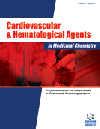- Home
- A-Z Publications
- Cardiovascular & Hematological Agents in Medicinal Chemistry (Formerly Current Medicinal Chemistry - Cardiovascular & Hematological Agents)
- Previous Issues
- Volume 7, Issue 2, 2009
Cardiovascular & Hematological Agents in Medicinal Chemistry (Formerly Current Medicinal Chemistry - Cardiovascular & Hematological Agents) - Volume 7, Issue 2, 2009
Volume 7, Issue 2, 2009
-
-
New Perspectives to Repair a Broken Heart
More LessAuthors: R. Gaetani, L. Barile, E. Forte, I. Chimenti, V. Ionta, A. Di Consiglio, F. Miraldi, G. Frati, E. Messina and A. GiacomelloThe aim of cardiac cell therapy is to restore at least in part the functionality of the diseased or injured myocardium by the use of stem/progenitor cells. Recent clinical trials have shown the safety of cardiac cell therapy and encouraging efficacy results. A surprisingly wide range of non-myogenic cell types improves ventricular function, suggesting that benefits may result in part from mechanisms that are distinct from tr Read More
-
-
-
Circulating Biochemical Markers of Brain Damage in Infants Complicated by Ischemia Reperfusion Injury
More LessHypoxia-ischemia constitutes a risk in infants by altering cerebral blood flow regulatory mechanisms and causing loss of cerebral vascular auto-regulation. Hypotension, cerebral ischemia, and reperfusion are the main events involved in vascular auto-regulation leading to cell death and tissue damage. Reperfusion could be critical since organ damage, particularly of the brain, may be amplified during this period. An exag Read More
-
-
-
Cardiac Regeneration by Progenitor Cells: What Is It Known as and What Is It Still to Be Known as?
More LessAuthors: Massimo F. Piepoli and Alessandro CapucciReperfusion therapy has significantly improved survival and prognosis of patients with acute myocardial infarction. However, the development of heart failure, particularly in patients after a large myocardial damage, remains a major challenge. Cell therapy may provide a novel therapeutic option to modify left ventricular remodeling processes and prevent postinfarction heart failure. Experimental studies have suggested th Read More
-
-
-
Recent Developments in Pharmacologic Prophylaxis of Atrial Fibrillation in Patients Undergoing Surgical Revascularization
More LessAtrial fibrillation is a frequent complication after CABG. It occurs in 20-50% of patients, most often between the 2nd and 3rd postoperative day. About 40 % of patients experience more than 1 episode. Postoperative AF (POAF) is associated with an increase in adverse events and hospital stay and, therefore, costs of care. The incidence of POAF is not influenced by the technique of CABG with or without cardiopulmonary by-pas Read More
-
-
-
Aeruginosin Analogs and Other Compounds with Rigid Bicyclic Structure as Potential Antithrombotic Agents
More LessAuthors: Guijun Wang and Navneet GoyalDirect inhibition of blood coagulation factors such as thrombin, factor VIIa, and factor Xa has shown great promise for treating thrombosis disorders. Inhibitors of these serine proteases have been designed, synthesized, and evaluated. Small molecule thrombin inhibitors typically contain P1-P2-P3 components targeting the active binding site. Structure optimizations on the P1 position and the P3 position have been done e Read More
-
-
-
Contrast Medium Induced Nephropathy: New Insights into Prevention and Risk Management
More LessAuthors: M. Vercellino, G. P. Bezante and M. BalbiDiagnostic and interventional cardiac imaging modalities employing contrast media (CMs) have become increasingly widespread in the recent years, especially multi-slice coronary computed tomography (MSCCT) and percutaneous coronary intervention (PCI). Contrast medium induced nephropathy (CIN), defined as impairment of renal function within 48-72 hours after administering CM, is one of the most common caus Read More
-
Volumes & issues
-
Volume 23 (2025)
-
Volume 22 (2024)
-
Volume 21 (2023)
-
Volume 20 (2022)
-
Volume 19 (2021)
-
Volume 18 (2020)
-
Volume 2 (2020)
-
Volume 17 (2019)
-
Volume 16 (2018)
-
Volume 15 (2017)
-
Volume 14 (2016)
-
Volume 13 (2015)
-
Volume 12 (2014)
-
Volume 11 (2013)
-
Volume 10 (2012)
-
Volume 9 (2011)
-
Volume 8 (2010)
-
Volume 7 (2009)
-
Volume 6 (2008)
-
Volume 5 (2007)
-
Volume 4 (2006)
Most Read This Month
Article
content/journals/chamc
Journal
10
5
false
en


